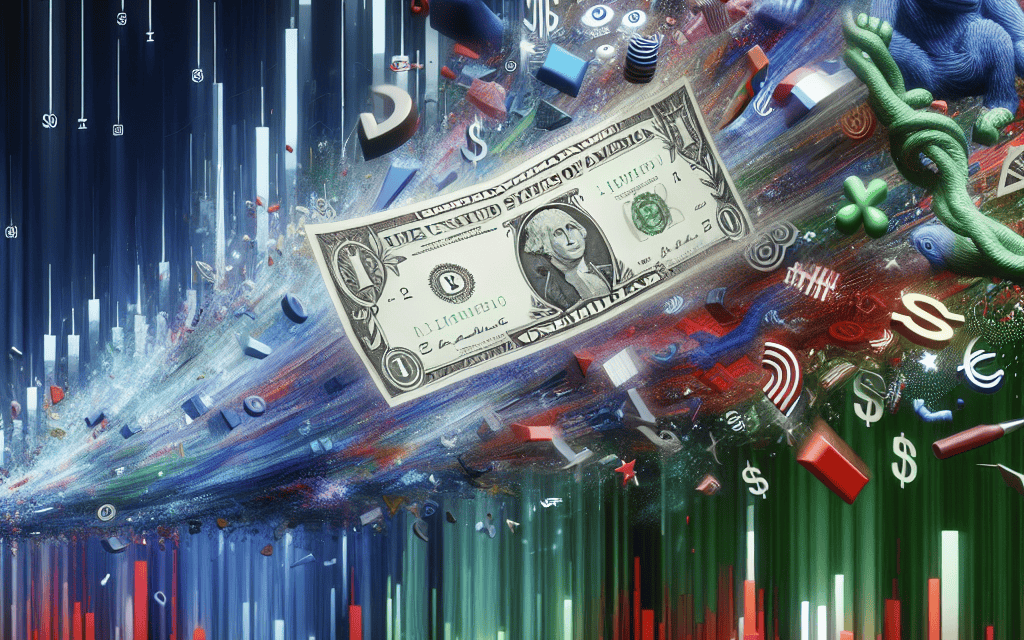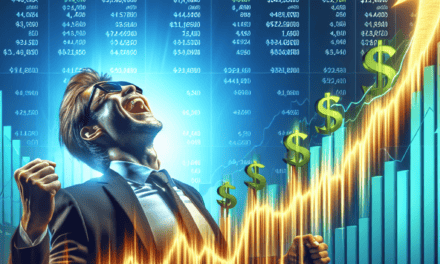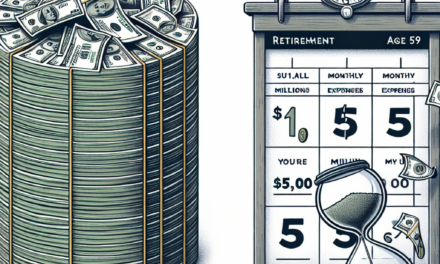“US Dollar Wavers as Election Uncertainty Shakes Market Confidence.”
Introduction
The US dollar experienced a decline as uncertainty surrounding upcoming election polls created volatility in the financial markets. Investors are closely monitoring the political landscape, as the potential outcomes of the elections could significantly impact economic policies and international relations. This uncertainty has led to cautious trading, with market participants seeking safer assets and reevaluating their portfolios. The fluctuating dollar reflects broader concerns about the stability and direction of the US economy, as well as the potential implications for global trade and investment. As the election date approaches, market analysts anticipate continued fluctuations in currency values, driven by the evolving political climate and its perceived impact on future economic conditions.
Impact Of Election Uncertainty On The US Dollar
The US dollar, a cornerstone of global financial markets, has recently experienced a dip in value, a movement closely tied to the uncertainty surrounding upcoming election polls. This fluctuation in the dollar’s strength is not an isolated incident but rather a reflection of broader market sentiments and investor behavior. As the election season progresses, the financial markets are keenly attuned to the potential outcomes and their implications for economic policy, trade agreements, and international relations. Consequently, the dollar’s performance is being scrutinized as a barometer of investor confidence and economic stability.
In times of political uncertainty, investors often seek safe-haven assets, which traditionally include currencies like the Swiss franc and the Japanese yen. The US dollar, typically a stalwart in this category, is currently facing headwinds due to the unpredictable nature of the election polls. This unpredictability stems from a variety of factors, including fluctuating voter sentiments, the emergence of new political issues, and the dynamic nature of campaign strategies. As a result, investors are exhibiting caution, leading to a decrease in demand for the dollar as they diversify their portfolios to mitigate potential risks.
Moreover, the impact of election uncertainty on the US dollar is further compounded by the broader economic context. The global economy is still grappling with the aftereffects of the COVID-19 pandemic, supply chain disruptions, and inflationary pressures. These factors contribute to a complex economic landscape where the outcomes of the US elections could significantly influence fiscal and monetary policies. For instance, different political parties may prioritize varying approaches to taxation, government spending, and regulatory frameworks, all of which have direct implications for economic growth and currency valuation.
In addition to domestic factors, international considerations also play a crucial role in shaping the dollar’s trajectory. The US’s relationships with key trading partners and its stance on international agreements are pivotal in determining the dollar’s strength. Election outcomes could lead to shifts in foreign policy, affecting trade dynamics and, consequently, the demand for the US dollar in global markets. Investors are acutely aware of these potential changes and are adjusting their strategies accordingly, contributing to the dollar’s current volatility.
Furthermore, the role of central banks cannot be overlooked in this context. The Federal Reserve’s monetary policy decisions are closely linked to economic indicators and political developments. As election uncertainty looms, the Fed may adopt a cautious approach, potentially influencing interest rates and liquidity in the financial system. Such decisions have a direct impact on the dollar’s value, as they affect investor expectations and capital flows.
In conclusion, the dip in the US dollar amid uncertain election polls is a multifaceted issue that reflects the intricate interplay between political developments, economic conditions, and investor behavior. As the election date approaches, market participants will continue to monitor polls and political discourse, seeking clarity on the future direction of US policies. This period of uncertainty underscores the importance of understanding the broader economic and geopolitical context in which currency fluctuations occur. Ultimately, the dollar’s performance will hinge on the resolution of these uncertainties and the subsequent actions taken by policymakers and market participants alike.
Historical Trends: US Dollar Fluctuations During Election Years
The US dollar has long been a barometer of economic confidence, and its fluctuations during election years often reflect the uncertainty and anticipation that accompany the political process. Historically, the dollar’s performance in these years can be attributed to a variety of factors, including market sentiment, policy expectations, and geopolitical considerations. As the US dollar dips amid uncertain election polls, it is essential to examine the historical trends that have characterized its behavior during previous election cycles.
In the lead-up to an election, the currency markets often experience heightened volatility as investors attempt to gauge the potential outcomes and their implications for economic policy. This uncertainty can lead to fluctuations in the value of the US dollar, as market participants adjust their positions based on perceived risks and opportunities. For instance, during the 2008 election, the financial crisis played a significant role in driving the dollar’s movements, as investors sought safe-haven assets amid global economic turmoil. Similarly, the 2016 election saw the dollar strengthen in the aftermath of unexpected results, as markets recalibrated their expectations for fiscal and monetary policy.
Moreover, the dollar’s performance during election years is often influenced by the candidates’ proposed economic policies. Investors closely scrutinize these proposals, assessing their potential impact on growth, inflation, and interest rates. For example, tax reform, trade policies, and government spending plans can all have significant implications for the dollar’s value. In 2000, the contested election between George W. Bush and Al Gore led to a period of uncertainty that weighed on the dollar, as markets awaited clarity on the future direction of economic policy.
In addition to domestic factors, global economic conditions also play a crucial role in shaping the dollar’s trajectory during election years. The interconnectedness of the global economy means that developments abroad can have a profound impact on the US currency. For instance, during the 2012 election, the eurozone crisis was a dominant theme, influencing investor sentiment and contributing to fluctuations in the dollar’s value. Similarly, trade tensions and geopolitical events can create additional layers of complexity, as markets navigate the interplay between domestic and international factors.
Furthermore, the Federal Reserve’s monetary policy decisions are a critical component of the dollar’s performance during election years. The central bank’s actions, or anticipated actions, regarding interest rates and other monetary tools can significantly influence the currency’s value. In 2004, for example, the Fed’s decision to raise interest rates contributed to a strengthening of the dollar, as higher rates attracted foreign investment. Conversely, expectations of monetary easing can lead to a weaker dollar, as lower rates reduce the currency’s appeal to investors.
As we observe the current dip in the US dollar amid uncertain election polls, it is evident that historical trends provide valuable insights into the factors that drive currency fluctuations during election years. By understanding the interplay between market sentiment, policy expectations, and global economic conditions, investors can better navigate the complexities of the currency markets. While each election cycle presents its unique challenges and opportunities, the lessons of the past offer a framework for anticipating the potential impacts on the US dollar in the present and future.
Investor Strategies Amid US Dollar Volatility
In the ever-evolving landscape of global finance, the US dollar has long been a cornerstone of stability and a benchmark for investors worldwide. However, recent fluctuations in its value, particularly amid uncertain election polls, have prompted investors to reassess their strategies. As the political climate in the United States becomes increasingly unpredictable, the dollar’s volatility has emerged as a focal point for market participants seeking to navigate these turbulent waters.
To begin with, the US dollar’s recent dip can be attributed to a confluence of factors, with political uncertainty playing a pivotal role. As election polls present a fragmented picture of potential outcomes, investors are left grappling with the implications of various scenarios. This uncertainty has led to a cautious approach, with many opting to diversify their portfolios to mitigate potential risks. Consequently, the demand for alternative assets, such as gold and cryptocurrencies, has seen a notable uptick, as these are often perceived as safe havens during times of currency instability.
Moreover, the Federal Reserve’s monetary policy decisions continue to exert significant influence over the dollar’s trajectory. With inflationary pressures mounting, the central bank’s stance on interest rates remains a critical determinant of the dollar’s strength. Investors are keenly attuned to any signals from the Fed regarding potential rate hikes or adjustments to its quantitative easing program. Such policy shifts could either bolster the dollar by attracting foreign investment or, conversely, exacerbate its decline if perceived as insufficient to curb inflation.
In light of these dynamics, investors are increasingly adopting a multi-faceted approach to manage currency risk. One strategy gaining traction is the use of currency hedging instruments, such as futures and options, which allow investors to lock in exchange rates and protect against adverse movements. Additionally, some are turning to currency-hedged exchange-traded funds (ETFs) as a means to gain exposure to international markets while minimizing the impact of currency fluctuations on returns.
Furthermore, geographical diversification remains a cornerstone of prudent investment strategy amid dollar volatility. By allocating assets across various regions, investors can reduce their reliance on the US dollar and capitalize on growth opportunities in emerging markets. This approach not only mitigates currency risk but also positions investors to benefit from the economic recovery in regions less affected by US political uncertainty.
In addition to these strategies, maintaining a long-term perspective is crucial for investors navigating the current environment. While short-term volatility can be unsettling, it is essential to recognize that currency markets are inherently cyclical. By focusing on fundamental economic indicators and maintaining a disciplined investment approach, investors can weather the storm and potentially capitalize on opportunities that arise from temporary market dislocations.
In conclusion, the US dollar’s recent dip amid uncertain election polls underscores the importance of strategic planning and adaptability in investment decision-making. As political and economic landscapes continue to shift, investors must remain vigilant and proactive in managing currency risk. By employing a combination of hedging techniques, geographical diversification, and a long-term perspective, they can navigate the complexities of the current market environment and position themselves for success in the face of ongoing volatility.
Global Market Reactions To US Election Polls

The global financial markets have been closely monitoring the fluctuations of the US dollar, particularly as the nation approaches another pivotal election period. Recent polls have introduced a layer of uncertainty, causing the dollar to dip against a basket of major currencies. This development has sparked a series of reactions across global markets, reflecting the intricate interplay between political events and economic indicators.
To begin with, the US dollar’s decline can be attributed to the heightened uncertainty surrounding the upcoming elections. Investors, wary of potential shifts in economic policy, have been adjusting their portfolios in anticipation of possible changes in the political landscape. This cautious approach has led to a decrease in demand for the dollar, as market participants seek to hedge against potential volatility. Consequently, the dollar index, which measures the currency against six major counterparts, has experienced a noticeable drop.
In response to the dollar’s weakening, other currencies have gained ground. The euro, for instance, has appreciated as investors perceive the European market as a relatively stable alternative amidst the US political uncertainty. Similarly, the Japanese yen, often considered a safe-haven currency, has seen increased demand. This shift underscores the global market’s sensitivity to US political developments and highlights the interconnectedness of international financial systems.
Moreover, the impact of the dollar’s dip extends beyond currency markets. Commodity prices, particularly those denominated in dollars, have also been affected. Gold, traditionally viewed as a hedge against currency depreciation and economic instability, has seen a rise in prices. This trend reflects investors’ inclination to seek refuge in tangible assets during periods of uncertainty. Additionally, oil prices have experienced fluctuations, influenced by the dollar’s value and broader market sentiment.
Transitioning to the equity markets, the dollar’s decline has had mixed effects. On one hand, a weaker dollar can benefit US exporters by making their goods more competitively priced on the global stage. This potential boost to export-driven sectors has provided some support to US stock indices. On the other hand, the uncertainty surrounding the elections has led to increased volatility, with investors remaining cautious about making significant moves until clearer signals emerge from the political arena.
Furthermore, the bond market has not been immune to these developments. Yields on US Treasury bonds have experienced fluctuations as investors weigh the implications of potential policy changes post-election. The prospect of shifts in fiscal policy, taxation, and government spending has introduced an element of unpredictability, prompting investors to reassess their strategies.
In conclusion, the recent dip in the US dollar amid uncertain election polls has reverberated across global markets, influencing currencies, commodities, equities, and bonds. As investors navigate this period of uncertainty, their strategies reflect a broader attempt to mitigate risk and capitalize on potential opportunities. The interconnected nature of global financial systems ensures that developments in one region can have far-reaching implications, underscoring the importance of closely monitoring political events and their economic ramifications. As the election date approaches, market participants will continue to scrutinize polls and policy signals, seeking clarity in an environment characterized by unpredictability.
Analyzing The Correlation Between Poll Results And Currency Markets
The recent fluctuations in the value of the US dollar have captured the attention of investors and analysts alike, as uncertain election polls have introduced a new layer of complexity to the currency markets. Historically, the US dollar has been perceived as a safe-haven currency, attracting investors during times of global uncertainty. However, domestic political instability, particularly surrounding elections, can lead to volatility in its value. As the upcoming election approaches, the correlation between poll results and currency markets has become increasingly evident, with the dollar experiencing dips in response to shifting political landscapes.
To understand this phenomenon, it is essential to consider the factors that influence currency markets. Currency values are primarily driven by economic indicators, interest rates, and geopolitical stability. In the context of an election, the potential for policy changes can significantly impact these factors. For instance, if a candidate perceived as business-friendly gains traction in the polls, it may lead to expectations of economic growth and stability, thereby strengthening the dollar. Conversely, if a candidate with policies that are viewed as potentially disruptive to economic growth gains popularity, it can lead to uncertainty and a subsequent weakening of the dollar.
The current election cycle has been marked by a high degree of unpredictability, with polls showing fluctuating support for candidates across the political spectrum. This uncertainty has been reflected in the currency markets, where the dollar has experienced periods of both strength and weakness. Investors are closely monitoring poll results, as they provide insights into potential election outcomes and the subsequent economic policies that may be implemented. As a result, even minor shifts in polling data can lead to significant movements in the currency markets.
Moreover, the global context cannot be ignored when analyzing the correlation between poll results and currency markets. The US dollar is not only influenced by domestic factors but also by international developments. In times of global economic uncertainty, such as trade tensions or geopolitical conflicts, the dollar often benefits from its status as a reserve currency. However, when domestic political uncertainty is introduced, it can offset this advantage, leading to a more complex interplay of factors that influence the dollar’s value.
In addition to the direct impact of poll results on currency markets, there is also an indirect effect through investor sentiment. Market participants often react to perceived risks and opportunities, and election polls can serve as a barometer for these perceptions. When polls suggest a close or contentious election, it can lead to increased market volatility as investors seek to hedge against potential risks. This heightened volatility can further exacerbate fluctuations in the dollar’s value, creating a feedback loop that amplifies the impact of political uncertainty on currency markets.
In conclusion, the correlation between election poll results and currency markets is a multifaceted relationship that reflects the interplay of economic, political, and psychological factors. As the election approaches, the US dollar is likely to continue experiencing volatility in response to shifting poll dynamics. Investors and analysts will need to remain vigilant, closely monitoring both domestic and international developments to navigate the complexities of the currency markets during this uncertain period. Understanding the nuances of this correlation will be crucial for making informed decisions in an ever-evolving financial landscape.
Expert Opinions On The Future Of The US Dollar
The recent fluctuations in the value of the US dollar have captured the attention of investors and economists alike, as uncertain election polls contribute to a volatile market environment. As the political landscape in the United States becomes increasingly unpredictable, experts are weighing in on the potential future of the US dollar, offering insights that are both varied and thought-provoking. The interplay between political uncertainty and currency valuation is complex, and understanding this relationship is crucial for anticipating future trends.
To begin with, the US dollar has long been considered a safe-haven currency, attracting investors during times of global instability. However, the current domestic political climate, characterized by contentious election polls, has introduced a new layer of uncertainty. This has led to a dip in the dollar’s value, as investors seek to hedge against potential risks associated with the outcome of the elections. The possibility of significant policy shifts, depending on which party gains control, adds to the apprehension surrounding the dollar’s future trajectory.
Moreover, experts highlight that the dollar’s performance is not solely influenced by domestic factors. Global economic conditions, including interest rates set by other major economies and geopolitical tensions, also play a significant role. For instance, if other central banks decide to tighten their monetary policies, the relative attractiveness of the US dollar could diminish, leading to further depreciation. Conversely, if global economic growth slows, the dollar might regain its appeal as a safe-haven asset, potentially stabilizing its value.
In addition to these external factors, the Federal Reserve’s monetary policy decisions are pivotal in shaping the dollar’s future. The Fed’s approach to interest rates and inflation targets can either bolster or weaken the dollar. Should the Fed opt for a more dovish stance, maintaining lower interest rates for an extended period, the dollar might face downward pressure. On the other hand, a hawkish shift, characterized by rate hikes, could strengthen the currency by attracting foreign investment seeking higher returns.
Furthermore, trade dynamics and fiscal policies enacted by the US government will inevitably influence the dollar’s path. Trade agreements, tariffs, and government spending all have the potential to impact the currency’s value. For example, expansive fiscal policies that lead to increased government borrowing might raise concerns about the long-term sustainability of US debt, thereby affecting investor confidence in the dollar.
As experts continue to analyze these multifaceted influences, it becomes evident that predicting the future of the US dollar is a challenging endeavor. The interplay between domestic political developments and global economic trends creates a dynamic environment where the dollar’s value is subject to rapid changes. Nevertheless, some analysts remain cautiously optimistic, suggesting that the inherent resilience of the US economy and its status as a global financial leader could provide a buffer against prolonged depreciation.
In conclusion, while the current dip in the US dollar amid uncertain election polls presents challenges, it also underscores the importance of a nuanced understanding of the factors at play. As investors and policymakers navigate this complex landscape, expert opinions offer valuable perspectives on the potential future of the US dollar. By considering both domestic and international influences, stakeholders can better prepare for the uncertainties that lie ahead, ensuring informed decision-making in an ever-evolving market.
Safe Haven Currencies: Alternatives To The US Dollar During Election Uncertainty
In the ever-fluctuating world of foreign exchange, the US dollar has long been regarded as a cornerstone of stability. However, during periods of political uncertainty, such as the lead-up to a contentious election, its status as a safe haven currency can be challenged. Recent polls indicating a tight race in the upcoming US elections have led to a dip in the dollar’s value, prompting investors to seek alternatives that offer security amidst the volatility. This shift underscores the importance of understanding the dynamics of safe haven currencies and their role in providing stability during uncertain times.
Traditionally, the US dollar has been the go-to currency for investors seeking refuge from market turbulence. Its global dominance, backed by the strength of the US economy and its status as the world’s primary reserve currency, has made it a reliable choice. However, when domestic political landscapes become unpredictable, as evidenced by the current election polls, the dollar’s appeal can wane. In such scenarios, investors often turn their attention to other currencies that are perceived as safe havens, each offering unique advantages.
One prominent alternative is the Swiss franc, renowned for its stability and the robust Swiss financial system. Switzerland’s long-standing policy of neutrality and its strong economic fundamentals make the franc an attractive option for investors seeking to mitigate risk. Moreover, the Swiss National Bank’s commitment to maintaining low inflation further enhances the franc’s appeal during periods of uncertainty. As a result, the Swiss franc often experiences increased demand when the US dollar faces headwinds due to political factors.
Similarly, the Japanese yen is another currency that investors frequently consider during times of uncertainty. Japan’s large current account surplus and its status as a net creditor nation contribute to the yen’s reputation as a safe haven. Additionally, the Bank of Japan’s monetary policy, which emphasizes stability, provides further assurance to investors. The yen’s historical performance during global crises has solidified its position as a reliable alternative to the US dollar, particularly when political events in the United States create market unease.
In addition to these traditional safe haven currencies, the euro has emerged as a viable option for investors seeking diversification. The eurozone’s economic resilience and the European Central Bank’s proactive measures to ensure financial stability have bolstered confidence in the euro. While the euro may not have the same historical safe haven status as the Swiss franc or the Japanese yen, its growing role in global trade and finance makes it an increasingly attractive choice for those looking to hedge against US political uncertainty.
As investors navigate the complexities of currency markets during election cycles, it is crucial to consider the broader geopolitical landscape and the potential implications for safe haven currencies. While the US dollar remains a dominant force, its vulnerability to domestic political developments highlights the need for diversification. By exploring alternatives such as the Swiss franc, Japanese yen, and euro, investors can better position themselves to weather the storms of uncertainty.
In conclusion, the recent dip in the US dollar amid uncertain election polls serves as a reminder of the dynamic nature of currency markets. As political events unfold, the search for stability leads investors to explore safe haven currencies that offer security and resilience. Understanding the unique attributes of these alternatives allows investors to make informed decisions, ensuring that their portfolios remain robust in the face of political and economic challenges.
Q&A
1. **What is causing the US dollar to dip?**
Uncertain election polls are causing the US dollar to dip as investors react to potential political instability.
2. **How are investors reacting to the uncertain election polls?**
Investors are seeking safer assets, leading to a sell-off of the US dollar and increased demand for gold and government bonds.
3. **What impact does a weaker US dollar have on global markets?**
A weaker US dollar can lead to increased volatility in global markets, affecting trade balances and commodity prices.
4. **Which currencies are gaining strength against the US dollar?**
Currencies such as the euro, Japanese yen, and Swiss franc are gaining strength against the US dollar amid the uncertainty.
5. **How might the election outcome affect the US dollar in the long term?**
The election outcome could lead to policy changes that impact economic growth, influencing the long-term strength or weakness of the US dollar.
6. **What are analysts predicting for the US dollar in the short term?**
Analysts predict continued volatility for the US dollar in the short term as election-related uncertainties persist.
7. **What strategies are traders using in response to the US dollar’s dip?**
Traders are employing strategies such as hedging with options and diversifying portfolios to mitigate risks associated with the US dollar’s dip.
Conclusion
The recent dip in the US Dollar can be attributed to the uncertainty surrounding upcoming election polls, which has led to increased market volatility. Investors are cautious as they assess the potential impact of the election outcomes on economic policies and international relations. This uncertainty has prompted a shift towards safer assets, weakening the dollar’s position. As the election date approaches, market participants will closely monitor polling data and political developments, which are likely to continue influencing currency fluctuations. The situation underscores the interconnectedness of political events and financial markets, highlighting the need for strategic risk management in times of political uncertainty.





